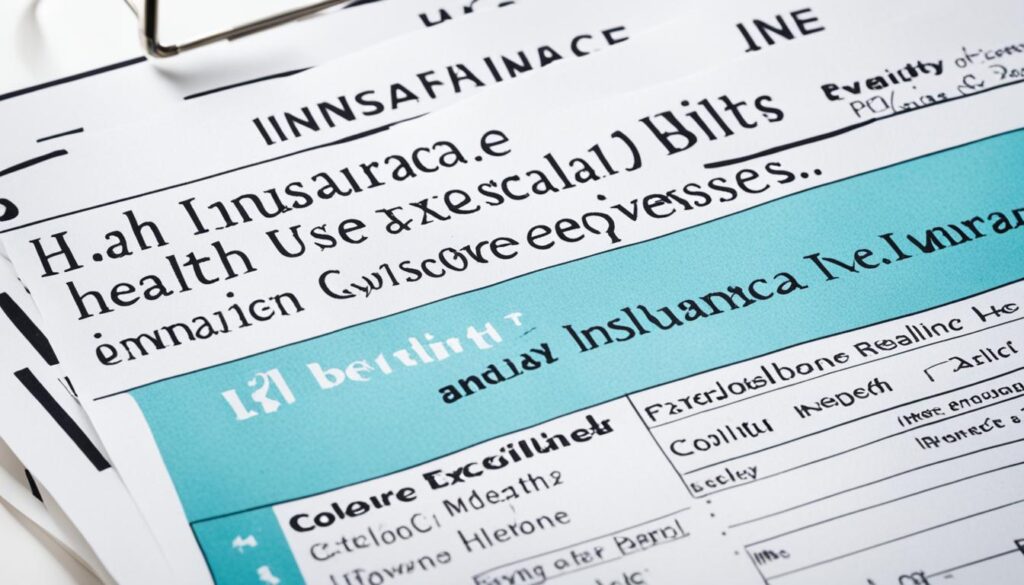Did you know that up to 80% of all medical bills contain errors? As healthcare costs continue to soar, understanding the landscape of medical expenses is more critical than ever, especially when it comes to balancing health insurance premiums and medical expenses. With 25 states implementing laws to partially or fully protect patients from surprise bills, navigating this complex field is essential for effective healthcare financial planning1. As you dive into the intricacies of health insurance and medical expenses, recognizing how to strike a balance can lead to substantial savings and informed healthcare choices.
By the end of this article, you will gain insights into various aspects of healthcare costs, including the importance of understanding your medical expenses, health insurance basics, and practical strategies for effective financial planning.
Key Takeaways
- Understanding medical expenses is crucial for effective financial planning.
- Health insurance premiums can significantly impact overall healthcare costs.
- 40-80% of medical bills contain errors, affecting out-of-pocket expenses.
- Recent laws protect individuals from surprise medical billing during emergencies.
- Balancing health insurance premiums and medical expenses can lead to better financial stability.
Understanding Medical Expenses
Medical expenses represent a significant financial consideration for many households. These costs encompass a wide array of services and items necessary for the prevention, diagnosis, and treatment of health conditions. They can often lead to confusion and financial strain on consumers, with around 72% of American consumers stating they are perplexed by their medical bills2.
Definition of Medical Expenses
Medical expenses include costs arising from a variety of healthcare services. This can range from premiums for health and dental insurance, visits to doctors, and expenses related to hospital stays. Many of these expenses can either be reimbursable by insurance or considered out-of-pocket costs that consumers must pay directly. Understanding what constitutes an allowable medical expense is crucial for effective budgeting.
Types of Medical Expenses
There are various types of medical expenses that individuals may incur:
- Reimbursable Expenses: Costs covered by health insurance plans, including co-pays and deductibles.
- Non-reimbursable Expenses: Out-of-pocket payments for services not covered by insurance.
- Preventive Care: Services such as vaccinations and screenings aimed at preventing health issues.
- Prescription Medications: Costs for medications prescribed by healthcare providers.
Tax deductibility of medical expenses is a key aspect to consider. For example, medical expenses can be deducted on taxes if they exceed 7.5% of a taxpayer’s adjusted gross income (AGI), providing potential relief for significant healthcare costs3. The Consolidated Appropriations Act of 2021 further adjusted the deduction threshold from 10% to 7.5%, making it more accessible to taxpayers3.
Tax Deductibility of Medical Expenses
The tax deductibility of medical expenses allows individuals to claim certain healthcare costs on their tax returns. Health-related expenditures such as payments to medical professionals, hospital expenditures, and transportation costs to medical facilities are generally eligible for deductions. Notably, taxpayers aged 65 or older are entitled to federal health benefits under Medicare, which can ameliorate their medical costs23. Understanding the specifics around the deductibility criteria is essential for effective healthcare budgeting, especially as 94% of consumers report receiving medical bills they find excessively costly2.

Health Insurance Basics
Understanding health insurance is crucial for navigating the complex landscape of medical coverage. This type of insurance serves as a contract between the insured and the provider, offering financial support for various medical expenses. A significant aspect of health insurance basics includes knowing the different types of plans available, as many Americans rely on private plans from employers, directly from insurance companies, or through the Health Insurance Marketplace®4.
What is Health Insurance?
Health insurance protects individuals from high medical costs by covering a portion of their healthcare expenses. In the United States, many people also have public coverage from government programs like Medicare or Medicaid4. Key features of health insurance include various plan types, such as Health Maintenance Organizations (HMOs), which focus on in-network providers and preventive care, and Preferred Provider Organizations (PPOs), which offer more flexibility for out-of-network services with additional costs4.
Premiums, Deductibles, and Co-pays
Health insurance plans come with specific cost sharing elements: premiums, deductibles, and co-pays. The average annual premium for employer-sponsored family plans was around $21,342 in 20205. Consumers need to pay deductibles before insurance coverage begins; these are amounts they must cover out-of-pocket before receiving benefits4. Co-pays are fixed fees paid for certain services after the deductible is met and help manage healthcare costs5.

To enhance financial planning, understanding these components aids consumers in choosing plans that align with their healthcare needs and budgets. The interaction between deductibles and co-pays impacts the overall costs covered by insurance and out-of-pocket spending for individuals4.
The Role of Out-of-Pocket Costs
Understanding out-of-pocket costs is crucial for navigating healthcare expenses effectively. These costs include any medical payments that individuals must make which are not covered by their insurance plans. Familiarity with out-of-pocket costs allows consumers to anticipate their financial responsibilities when it comes to healthcare.
What Are Out-of-Pocket Costs?
Out-of-pocket costs encompass various expenses such as premiums, deductibles, copayments, and non-covered services. For instance, in the U.S., out-of-pocket spending is particularly significant; in 2017, approximately one in 100 Americans under age 64 spent $5,000 or more out of pocket for medical services, while about 1 in 20 spent over $1,7006. This highlights the real financial burdens faced by individuals, especially those in the top 1 percent of spenders who averaged more than $10,500 in out-of-pocket expenses annually from 2015 to 20176.
Examples of Out-of-Pocket Medical Expenses
The most common types of out-of-pocket expenses include:
- Premiums: Regular payments for health insurance coverage.
- Deductibles: The amount paid out of pocket before insurance kicks in.
- Coinsurance: Costs shared between the insurer and the insured.
- Copayments: Fixed fees for specified services, contributing to out-of-pocket maximums.
- Non-covered services: Expenses not included in insurance plans, requiring full payment by the patient.
For example, in 2022, hospital spending accounted for nearly a third of overall health spending in the U.S., with physicians and clinics making up an additional 19.8%7. Awareness of these examples of out-of-pocket expenses empowers consumers to plan their healthcare finances.
How Out-of-Pocket Costs Affect Healthcare Choices
The implications of out-of-pocket costs significantly influence individual healthcare decisions. Many people may avoid necessary treatments due to high out-of-pocket expenses, leading to worse health outcomes. A reported trend shows that the top 5 percent of spenders accounted for half of health care spending in 20166. This indicates that a small percentage of the population drives a large portion of healthcare costs. Furthermore, monthly premiums and other out-of-pocket costs create financial decisions that individuals must navigate carefully, highlighting the importance of informed choosing of plans and services.
Balancing Health Insurance Premiums and Medical Expenses
Achieving equilibrium between balancing health insurance premiums and medical expenses necessitates smart strategies and thorough financial insights. As healthcare costs continue to rise, individuals must take proactive steps to ensure their premiums and out-of-pocket expenses do not spiral out of control.
Strategies for Balancing Costs
Employing effective strategies can lead to a better balance between health insurance premiums and medical expenses. Consider the following approaches:
- Choose a health insurance plan that aligns with your anticipated medical needs, focusing on plans with suitable deductibles.
- Utilize Health Savings Accounts (HSAs) to save on taxes while budgeting for medical expenses, allowing for tax-free withdrawals for qualifying healthcare expenditures.
- Engage in preventive care practices to reduce the likelihood of chronic conditions and unexpected high costs in the future.
Long-term Financial Planning for Healthcare
Long-term financial planning for healthcare is essential for avoiding unexpected financial burdens. Establishing a healthcare budget can facilitate effective management of both monthly premium payments and anticipated medical services. Furthermore, it is vital to forecast future medical costs to protect oneself from the stress of unplanned health-related expenses. By doing so, individuals can ensure adequate coverage while minimizing overspending.
The Impact of Surprise Medical Bills
Surprise medical bills can create significant financial stress for patients who unexpectedly receive care from out-of-network providers. In emergency situations, the likelihood of receiving surprise medical bills increases dramatically. About 18% of emergency visits for individuals with large employer coverage in 2017 involved at least one out-of-network charge, indicating how prevalent this issue is8. Additionally, data shows that 39% of insured nonelderly adults faced an unexpected medical bill within the last year, with 10% of those bills originating from out-of-network providers8. This situation demonstrates the urgent need for awareness surrounding surprise billing practices.
Understanding Surprise Billing
Surprise billing occurs primarily when patients inadvertently receive services from non-participating providers, often at in-network facilities. This can include emergency room visits where, despite visiting an in-network hospital, a patient may still be charged by out-of-network physicians. For instance, approximately 26% of emergency visits leading to inpatient admission resulted in an out-of-network charge8. Such unexpected medical expenses contribute significantly to stress, with two-thirds of adults expressing greater concern over these bills than over other healthcare costs9.
Consumer Protections Against Surprise Bills
To mitigate the impact of surprise medical bills, legislation such as the No Surprises Act has been enacted. This law protects patients by prohibiting out-of-network providers from billing beyond the in-network cost-sharing amount for surprise bills9. Furthermore, around 78% of Americans support such federal measures aimed at protecting consumers against unexpected medical expenses8. As regulations evolve, states like Texas have begun implementing their laws, banning balance billing in emergency care scenarios, benefiting many with private health insurance coverage10.
Healthcare Financial Planning
Effective healthcare financial planning is crucial for managing unexpected medical costs while ensuring your health needs are met. A structured approach to creating a healthcare budget helps individuals forecast potential medical expenses and insurance premiums, striking a balance between resources and healthcare needs.
Creating a Healthcare Budget
Establishing a comprehensive healthcare budget is essential to navigate the complexities of medical expenses. Begin by reviewing past medical bills to understand spending patterns and identify common costs. Budgeting should incorporate the following elements:
- Monthly premiums and deductibles, providing a baseline for insurance costs.
- Projected out-of-pocket expenses, including copayments for doctor visits and prescription medications.
- Emergency funds for unexpected healthcare costs, as about 1 in 5 Americans face the burden of medical debt, with approximately 58% of bills in collections being for medical issues11.
By analyzing this information, individuals can adjust their spending to fit their financial capabilities while maintaining adequate health coverage.
Cost-effective Health Coverage Options
Exploring cost-effective health coverage options can significantly enhance your healthcare financial planning. Consider the following options:
| Coverage Option | Description | Key Benefits |
|---|---|---|
| Health Savings Accounts (HSA) | Designed to help individuals save for medical expenses with tax benefits. | Tax-deductible contributions and tax-free withdrawals for qualified expenses12. |
| Medicare Supplemental Insurance (Medigap) | Private plans that cover expenses not paid by Medicare. | Enhanced coverage to tackle healthcare gaps and financial shortfalls. |
| Telehealth Services | Remote healthcare options that allow patients to consult healthcare providers virtually. | Cost-effective alternatives to in-person visits, minimizing travel and associated costs. |
Analyzing these options will aid in crafting a tailored strategy that aligns with personal financial goals while ensuring necessary healthcare access.
These strategies not only support informed decision-making but can also shield individuals from surprise medical costs and reduce financial stress in their health management journey111213.
Managing Medical Costs Effectively
The efficient management of medical costs is crucial for both individuals and employers. A combination of proactive strategies can lead to significant savings while ensuring necessary healthcare is accessible. Understanding effective ways to reduce expenses can create a healthier financial environment.
Tips for Reducing Medical Expenses
One effective approach to managing medical costs involves shopping around for healthcare services. This practice allows individuals to find the best value for their needs. Additionally, negotiating medical bills can result in lower payments, ensuring more manageable expenses. It’s also essential to utilize preventative care, which helps catch potential health issues early, reducing long-term costs. Many people might not be aware of support programs that offer financial assistance, making it important to research available resources.
Health Insurance Premium Management Strategies
Implementing health insurance premium strategies can be beneficial in managing overall medical costs. Understanding your plan options enables better decision-making when selecting health coverage. Employers should negotiate provider network discounts to achieve optimal outcomes at the most affordable prices14. Encouraging employees to adopt consumer-directed health plans (CDHPs) can lead to sustained positive behavior changes that lower health plan spending15. Organizing employee benefit committees assists in evaluating the financial impact of decisions related to managing medical costs effectively14. Periodic reviews of plan services ensure cost-effective healthcare benefits for employees while increasing awareness regarding healthcare expenses.
| Strategies | Description |
|---|---|
| Shopping for Services | Compare healthcare providers to find cost-effective options. |
| Negotiating Bills | Request reductions in billed amounts directly with healthcare providers. |
| Preventative Care | Regular check-ups to catch issues early and reduce long-term costs. |
| Provider Network Discounts | Secure lower rates through negotiations with healthcare networks. |
| CDHP Enrollment | Encourage participation in plans that promote cost-saving behaviors. |
| Benefit Committees | Collaborate to assess and manage healthcare cost impacts. |
Conclusion
Achieving a balance between health insurance premiums and medical expenses is crucial for effective healthcare financial planning. By understanding the intricacies of medical expenses and health insurance, individuals can strategically navigate their healthcare choices. This knowledge allows for better management of out-of-pocket costs, which is essential for minimizing financial stress while ensuring necessary health services are prioritized.
Furthermore, engaging with consumer protections against surprise medical bills can significantly enhance the financial well-being of individuals facing unexpected healthcare costs. As system-wide health care costs continue to rise, it becomes increasingly important to adopt strategies that focus on optimizing healthcare expenses and long-term budgeting. This proactive approach not only promotes financial stability but also empowers consumers to make informed decisions regarding their health care needs.
In an era of soaring healthcare expenditures, characterized by data indicating that healthcare costs per capita have increased significantly, being equipped with the right strategies is paramount. The financial landscape requires effective management of both health insurance premiums and associated medical expenses to ensure a sustainable and secure future for one’s health and finances1617.
FAQ
What are the main components of medical expenses?
How can I reduce my out-of-pocket medical costs?
What is the significance of understanding health insurance premiums?
How do surprise medical bills affect consumers?
What factors should I consider when creating a healthcare budget?
What are some strategies for balancing health insurance premiums and medical expenses?
Source Links
- https://www.phiagroup.com/Media/Industry-Articles/Balance-Billing-What-Patients-Need-To-Know
- https://www.medicalbillingandcoding.org/health-insurance-guide/understanding-medical-bills/
- https://www.investopedia.com/terms/m/medical-expenses.asp
- https://www.cms.gov/files/document/nsa-health-insurance-basics.pdf
- https://www.ehealthinsurance.com/resources/individual-and-family/health-insurance-101-a-comprehensive-guide-to-health-insurance
- https://www.commonwealthfund.org/publications/issue-briefs/2020/apr/catastrophic-out-of-pocket-costs-problem-middle-income
- https://www.kff.org/health-policy-101-health-care-costs-and-affordability/
- https://www.healthsystemtracker.org/brief/an-examination-of-surprise-medical-bills-and-proposals-to-protect-consumers-from-them-3/
- https://www.kff.org/private-insurance/fact-sheet/surprise-medical-bills-new-protections-for-consumers-take-effect-in-2022/
- https://www.texastribune.org/2020/01/02/what-you-need-to-know-about-texas-new-surprise-medical-billing-law/
- https://www.cnbc.com/2023/09/19/navigating-medical-bills-12-steps-for-managing-costs-minimizing-debt.html
- https://www.cbsnews.com/news/smart-ways-to-manage-healthcare-costs-during-retirement/
- https://www.ncbi.nlm.nih.gov/pmc/articles/PMC10060328/
- https://www.gfoa.org/materials/strategies-for-managing-health-care-costs
- https://www.shrm.org/topics-tools/tools/toolkits/managing-health-care-costs
- https://www.kff.org/report-section/health-care-costs-a-primer-2012-conclusion/view/print/
- https://www.ncbi.nlm.nih.gov/books/NBK234992/

